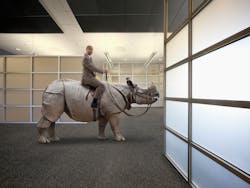Change and Risk Management
By Brian Moore, President, Kahua
From the start, construction project managers can count on project changes; and with change, there is also risk. Often driven by architects, owners and trade coordination, delays related to change can affect productivity and a project’s overall budget. In fact, lagging productivity within the construction industry is estimated to cost the U.S. global economy $1.6 trillion a year. A stakeholder’s ability to effectively manage change is essential to their organization’s and a project’s profitability.
Project risks can be classified into three primary categories:
· Design – occurs when/if a project team attempts to manage an unfinished design during the construction phase.
· Schedule – miscommunication can result in setbacks by weeks or even months and can have a detrimental impact on the project’s budget.
· Finance – the combination of poor planning and coordination which could affect the liquidity of the stakeholder.
Although natural disasters and other unexpected events can spur change, there are also several market trends within the industry that are creating additional pressures for stakeholders to effectively manage change and risk. This includes the continuing labor shortage of highly skilled construction workers. A study conducted by the Associated General Contractors of America, found hiring managers are still having difficulty filling the 600,000 construction jobs left vacant due to the recent recession. The study found that 29% of firms are putting longer completion times into their bids due to a lack of workers. This puts the future of commercial and capital infrastructure projects at risk.
Over the past several years, companies have invested heavily in technology to address many of the risk challenges that can derail a project. In less than a decade, more than $10 billion industrywide investments have been made to improve project insights. These investments include systems to enhance communication, streamline procedures and the collection of data to improve future processes.
Many companies are still utilizing traditional SaaS (Software as a Service) solutions which do not fully integrate and allow for collaboration. As a result, stakeholders, specifically contractors, lack the visibility and flexibility to efficiently mitigate project risks. This is because traditional SaaS solutions are project-centric and restrict collaboration among project participants resulting in challenges, including data ownership and control, inefficiency, and data management and aggregation. To thoroughly address risks associated with projects, companies utilizing a robust network solution can leverage three core concepts of collaborative change management:
Flexible Change Management Workflow
Specific procedures and workflows stakeholders have developed are central to their competitive advantage. For example, the management of an RFI, a change request and change order, and a request for quotation can impact profitability either positively or negatively. Traditional SaaS solutions force organizations to conform their processes to what is pre-defined within programming. As change management is inherently collaborative, the technology a company utilizes should give them the ability to manage across the project lifecycle with all participants, including subcontractors. By utilizing a solution leveraging the concept of collaborative change management, organizations can be agile enough to develop and design their own unique best practices within the software. This allows companies to continuously evolve their programming in response to customer demand and changing market conditions.
Cost Management Integration
Integration is essential for effectively managing a project with other stakeholders. This reduces the potential of incorrect data or duplicate documents and costs with being associated with the project. As changes are identified and resolved, companies need to be able to have a complete and accurate view of their project finances. This data will assist with bidding and budgeting on future projects.
Data Management Integration
As millions of emails and other documents are exchanged during the average project lifecycle, the earlier stakeholders understand the potential impact of a change request improves their ability and increases their prospective options to mitigate risk. With real-time visibility, stakeholders can immediately understand the risk to the budget and schedule when a document is created or modified. This process also creates the documentation and audit trails that are often vital to justifying change and for collecting reimbursement in a timely fashion.
As construction tech continues to advance the way stakeholders manage a project, companies that invest in robust collaboration systems will have a competitive edge. Effectively leveraging technology can assist with managing the complexity of change during a project. By investing in a network-based collaboration solution that efficiently integrates change management with both document and cost management, and enables flexible collaborative workflows, stakeholders can improve project outcomes and profitability.
Brian Moore, co-founder and president at Kahua, is a transformational entrepreneur with a passion for innovation and customer value. He helps the world’s leading owners, contractors, architects and engineers profitably deliver and manage the highest performance capital projects at the lowest possible lifecycle cost. Prior to Kahua, Brian was co-founder of Constructware, the first cloud-based SaaS solution for construction project management. Constructware was acquired by Autodesk in 2006, and Brian served on the Autodesk executive team following the acquisition. Brian holds a Bachelor of Science in industrial engineering from Auburn University.
